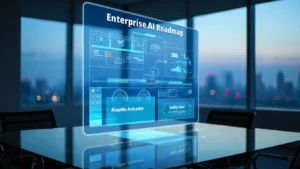Disaster Preparedness in Logistics: How AI Improves Response Strategies
Disaster preparedness in logistics is vital for minimizing supply chain disruptions, ensuring timely delivery of essential goods, and supporting recovery efforts. Traditionally, this has involved risk assessment, contingency planning, and emergency response coordination. However, these approaches can be reactive, relying on historical data. With natural disasters costing the global economy approximately $520 billion annually and pushing 26 million people into poverty each year, the importance of effective disaster preparedness cannot be overstated.
In the United States alone, there have been over 300 weather and climate disaster events since 1980, each causing losses exceeding $1 billion. Additionally, more than half of businesses have experienced supply chain disruptions due to natural disasters in a single year. The integration of advanced technologies like artificial intelligence (AI) is transforming disaster preparedness in logistics, offering more dynamic and predictive capabilities.
The Role of AI in Disaster Preparedness
Logistics is the backbone of effective disaster management. It encompasses the planning, implementation, and control of the efficient flow and storage of goods, services, and information from the point of origin to the point of consumption. In the context of disasters, logistics ensures that the right resources are available at the right time and place to support response and recovery efforts.
Essential Supply Delivery
A critical aspect of logistics in disaster management is the timely delivery of essential supplies such as food, water, medical equipment, and shelter materials to affected areas. This involves not only transportation but also warehousing and inventory management so that supplies are available when and where they are needed.
Coordination of Personnel and Equipment
Logistics also involves coordinating the movement of personnel and equipment for search and rescue operations, and for the delivery of aid. This includes managing the logistics of transportation, such as arranging for vehicles, aircraft, or boats, and scheduling and routing so that resources are utilized effectively.
Challenges in Supply Chain Disruption
One of the major challenges facing the logistics sector during disasters is the disruption of supply chains. Natural disasters like floods, earthquakes, or hurricanes can damage infrastructure, making transportation routes impassable and hampering communication networks. This disruption complicates the delivery of aid and hinders the flow of information, making it challenging to assess needs and coordinate efforts.
Adaptability to Unpredictability
The unpredictability and sudden onset of disasters require logistics systems to be flexible and adaptable. This means being able to respond quickly to changing situations and adjust plans as necessary. It also involves having contingency plans in place to deal with unexpected challenges.
Security Concerns
In disaster-stricken areas, security issues can arise, with the risk of looting or violence complicating logistics operations. Ensuring the safety of personnel and the security of supplies is a critical concern that adds another layer of complexity to logistics in disaster management.
Logistics plays a pivotal role in disaster management, ensuring that essential supplies and personnel are delivered efficiently and effectively to support response and recovery efforts. Despite the challenges, the logistics sector must continue to adapt and innovate to meet the demands of disaster management and help communities recover from crises.
Understanding AI in the Context of Logistics
Artificial Intelligence (AI) refers to simulating human intelligence in machines that are programmed to think and learn like humans. In logistics, AI is increasingly being used to improve various aspects of the supply chain and improve efficiency. Some of the key applications of AI in logistics include:
- Predictive Analytics: AI algorithms can analyze historical data and identify patterns to predict future trends, such as demand forecasting and inventory management.
- Route Optimization: AI can help optimize delivery routes by considering factors like traffic, weather, and delivery windows, reducing travel time and fuel consumption.
- Warehouse Automation: Robots and automated systems powered by AI can streamline warehouse operations, from sorting and picking to packing and shipping.
- Customer Service: AI-powered chatbots and virtual assistants can provide 24/7 customer support, answering queries and providing tracking information.
Leveraging AI for Disaster Preparedness
AI technologies can play a major role in optimizing disaster preparedness in logistics by:
- Risk Assessment: AI can analyze large datasets to identify potential risks and vulnerabilities in the supply chain, allowing organizations to take proactive measures to mitigate them.
- Resource Allocation: AI can help in the efficient allocation of resources, ensuring that critical supplies are stocked and distributed strategically in anticipation of disasters.
- Real-Time Monitoring: AI-enabled systems can monitor weather patterns, traffic conditions, and other factors in real-time, providing early warnings and allowing for swift adjustments to logistics plans.
- Simulation and Training: AI-driven simulations can be used to train logistics personnel in disaster response scenarios, improving their readiness and response capabilities.
AI has the potential to revolutionize logistics, making it more efficient, adaptable, and resilient, especially in the face of disasters. By leveraging AI technologies, logistics operations can be better prepared to handle the challenges posed by natural and man-made disasters, ensuring timely and effective delivery of essential supplies and services.
AI-Driven Solutions for Disaster Preparedness
Artificial Intelligence (AI) stands out as a powerful ally for the logistics sector. By harnessing the capabilities of AI, logistics companies can unlock a range of solutions that not only predict and mitigate risks but also guarantee a swift and effective response in the face of disasters. From anticipating disruptions to optimizing resource allocation, AI-driven solutions are transforming the landscape of disaster preparedness, offering unprecedented levels of efficiency and resilience. Let’s explore some of the key AI-driven solutions that are making this possible.
Predictive Analytics
Predictive analytics, powered by AI, is a game-changer for disaster preparedness in logistics. By analyzing historical data, AI algorithms can identify patterns and predict the likelihood of future disasters. For instance, AI can forecast weather events like hurricanes or floods and their potential impact on logistics networks. This allows logistics companies to pre-emptively reroute shipments, adjust inventory levels, and take other precautionary measures to minimize disruption. Moreover, predictive analytics can help in demand forecasting, ensuring that essential supplies such as food, water, and medical equipment are adequately stocked in anticipation of increased demand during disasters.
Risk Assessment and Management
AI tools evaluate and mitigate risks in logistics operations. By analyzing vast amounts of data, AI can identify potential vulnerabilities in the supply chain, such as areas prone to natural disasters or suppliers with a history of disruptions. This information enables logistics companies to develop risk management strategies, such as diversifying suppliers or strengthening infrastructure. Additionally, AI can continuously monitor for emerging risks, allowing for real-time adjustments to logistics plans for resilience in the face of unforeseen challenges.
Resource Allocation and Optimization
In disaster scenarios, the efficient allocation and optimization of resources are critical. AI algorithms can optimize the distribution of resources before and during disasters by analyzing various factors, such as the severity of the disaster, the needs of affected areas, and the availability of resources. This ensures that critical supplies are delivered where they are needed most, reducing waste and improving response times. AI can also optimize warehouse operations, ensuring that essential goods are readily accessible and can be quickly dispatched in emergency situations.
Real-Time Tracking and Monitoring
AI focuses on the visibility of goods and assets during crises through real-time tracking and monitoring. GPS and RFID technologies, combined with AI, enable logistics companies to track the location and condition of shipments in transit. This is particularly important during disasters, as it allows for the quick redirection of supplies to areas in need and that perishable or sensitive goods are maintained under optimal conditions. Real-time monitoring also provides valuable data for coordinating emergency response efforts and making informed decisions.
Automated Decision-Making
In disaster response cases, quick and effective decision-making is imperative. AI systems can automate decision-making processes, rapidly analyzing complex data to provide recommendations or even make decisions autonomously. For example, AI can prioritize the dispatch of critical supplies, determine the best routes for delivery, or automatically adjust logistics plans based on real-time developments. This automation speeds up the response time and reduces the potential for human error, boosting the overall efficiency of disaster preparedness and response efforts.
AI-driven solutions are transforming disaster preparedness in logistics. From predictive analytics to automated decision-making, AI technologies provide the tools needed to anticipate, assess, and respond to disasters effectively, ensuring that logistics operations remain resilient and responsive in the face of adversity.
Challenges and Solutions of AI in Disaster Preparedness
While AI presents a plethora of opportunities to improve disaster preparedness in logistics, it is not without its challenges. Addressing these hurdles is needed to fully leverage the potential of AI and ensure its effective implementation. From safeguarding data privacy to bridging the skill gap, logistics companies must navigate a complex landscape of obstacles. In this section, we’ll delve into the key challenges faced in integrating AI into disaster preparedness efforts and explore the solutions that can pave the way for a more secure and efficient future.
Data Privacy and Security
A major challenge in implementing AI for disaster preparedness is ensuring data privacy and security. AI systems require access to vast amounts of data, raising concerns about protecting sensitive information. To address this, implementing robust data encryption and access control measures is essential. Regular security audits and compliance with data protection regulations can further increase data privacy and security, ensuring that sensitive information is safeguarded against breaches or misuse.
Reliance on Technology
Over-reliance on AI and technology can lead to vulnerabilities, especially if systems fail during critical moments. To mitigate this risk, establishing backup systems and manual processes is a major part needed to ensure the continuity of operations in case of technological failures. Regular maintenance and updates of AI systems can also prevent malfunctions, reducing the risk of over-reliance on technology.
Data Quality and Availability
The effectiveness of AI in disaster preparedness depends heavily on data quality and availability. Inadequate or inaccurate data can lead to erroneous predictions and decisions. Investing in data collection and management infrastructure is vital to ensure the availability of high-quality data. Collaborating with partners and stakeholders can benefit data sharing and availability, improving the accuracy and reliability of AI predictions.
Integration with Existing Systems
Integrating AI solutions with existing logistics systems can be complex and costly. Adopting modular and scalable AI solutions can ease integration challenges. Collaboration with technology providers can facilitate the seamless implementation of AI into existing systems, ensuring compatibility and minimizing disruptions to operations.
Ethical and Legal Considerations
The use of AI raises ethical and legal concerns, such as accountability for decisions made by AI systems. Developing clear guidelines and ethical frameworks for AI use can address these concerns. Ensuring transparency in AI decision-making processes can increase accountability, fostering trust in AI-driven solutions for disaster preparedness.
Skill Gap and Training
The effective use of AI in disaster preparedness requires specialized skills, which may be lacking in the current workforce. Investing in training and development programs is essential to equip employees with the necessary AI skills. Collaborating with educational institutions can help bridge the skill gap, ensuring that the workforce is adequately prepared to leverage AI technologies for disaster preparedness.
Conclusion
AI holds tremendous potential to revolutionize disaster preparedness in logistics. By harnessing predictive analytics, risk assessment, resource optimization, real-time monitoring, and automated decision-making, AI can significantly improve the resilience and efficiency of logistics operations in the face of disasters. However, successfully leveraging AI requires addressing challenges related to data privacy, technology reliance, data quality, system integration, ethical considerations, and workforce skills. As the logistics industry continues to navigate these challenges, the integration of AI-driven solutions will undoubtedly play a pivotal role in shaping a more prepared and responsive future for disaster management.
Partner with RTS Labs to harness the power of AI-driven solutions. Contact us today to transform your logistics operations for a resilient future.






